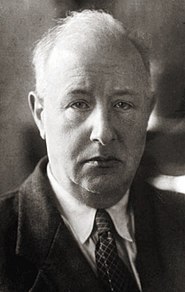Jakub Karol Parnas
Jakub Karol Parnas (born January 16, 1884 in Mokrzany , Austria-Hungary ; died January 29, 1949 in Moscow ) was a Polish - Soviet biochemist . Together with Gustav Embden and Otto Meyerhof , he clarified the mechanism of glycolysis in 1929 , which is also known as the Embden-Meyerhof-Parnas-Weg according to these researchers.
life and work
biography
Jakub Karol Parnas was born in 1884 in the village of Mokrzany near Ternopil . Parnas studied chemistry at the Technical University of Berlin from 1902 and moved to the University of Strasbourg in 1904 . In 1905 he moved to the Polytechnic in Zurich , where he received his diploma in 1906 and his doctorate in 1907. After his doctorate he went back to Strasbourg and got an assistant position with Franz Hofmeister and between 1910 and 1911 did a research stay in Naples. From 1913 he was a private lecturer in physiological chemistry in Strasbourg. In 1914 he went to the University of Cambridge , but had to end his stay when the First World War broke out. After the war he worked in Poland and, as a professor, built up the department of physiological chemistry at the University of Warsaw . In 1920 he went to Lviv University and became head of the Faculty of Medicinal Chemistry at the Medical Faculty, where he built up an active staff and worked in numerous collaborations with European colleagues. In 1939 he became a professor of biochemistry there.
In June 1941, before the German troops could take Lviv, Parnas was evacuated to Ufa in the Asian part of the Soviet Union and brought to Moscow in 1943, where he became director of the Institute for Biological and Medicinal Chemistry and head of the physiological laboratory. On January 29, 1949, he was detained in Moscow without explanation and he died in the Lubyanka , Moscow's central prison.
Scientific achievements
Jakub Karol Parnas and his colleagues are among the pioneers of work in the field of elucidating phosphorylation in biology. They were among the first to use radioactively labeled phosphate to clarify biochemical processes. The first process that Parnassus was able to explain in this way was the breakdown of glycogen to glucose-6-phosphate in the presence of inorganic phosphate .
In addition, his research group identified two of the three regulatory enzymes in glycolysis, namely phosphofructokinase 1 and pyruvate kinase . Through this discovery he succeeded in 1929 with Gustav Embden and Otto Meyerhof to elucidate the mechanism of glycolysis , which is also known as Embden-Meyerhof-Parnas-Weg according to these researchers.
In 1932 he became a member of the Leopoldina .
supporting documents
- ↑ a b c d e J. Barańska, A. Dzugaj, J. Kwiatkowska-Korczak, Giorgio Semenza : Jakub Karol Parnas - life and creativity. Opening Lecture for the 6th Parnas Conference Molecular Mechanism of Cellular Signaling in Kraków, Poland, May 30 - June 2, 2007, Acta Biochimica Polonica 54 (Suppl. 2), p. 1.
- ^ A b c "Parnas, Jakub Karul" In: Ilse Jahn (Ed.): History of Biology. Special edition 2004, Nikol Verlagsgesellschaft; Pp. 920-921. ISBN 3-937872-01-9 .
- ↑ Jolanta Barańska, Andrzej Dzugaj, Janina Kwiatkowska-Korczak: Embden-Meyerhof-Parnas, the First Metabolic Pathway: The Fate of Prominent Polish Biochemist Jakub Karol Parnas. Comprehensive Biochemistry 45, 2007 (Stories of Success - Personal Recollections.); Pp. 157-207. doi : 10.1016 / S0069-8032 (07) 45005-7
- ↑ Member entry of Jakob Parnas at the German Academy of Natural Scientists Leopoldina , accessed on February 14, 2016.
| personal data | |
|---|---|
| SURNAME | Parnas, Jakub Karol |
| BRIEF DESCRIPTION | Polish-Soviet biochemist |
| DATE OF BIRTH | January 16, 1884 |
| PLACE OF BIRTH | Mokrzany |
| DATE OF DEATH | January 29, 1949 |
| Place of death | Moscow |

